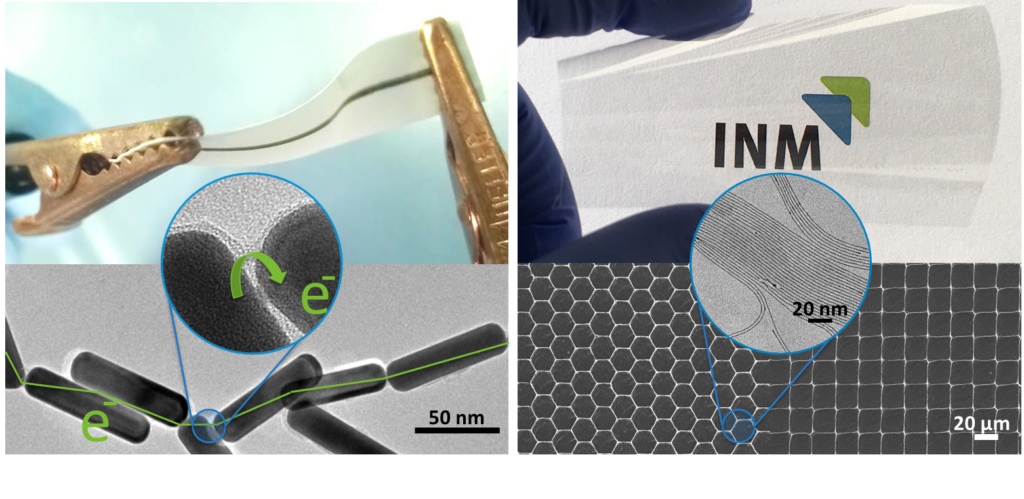Hybrid materials
Current projects
Transparent conductive materials based on nanoparticles
Flexible and printable electronics require new materials. In this project, we are looking at optically transparent materials for the electronics of the future. The BMBF-funded project, part of the NanoMatFutur program, uses nanoparticles with defined shapes and arrangements in polymers to produce transparent electrodes for touch-sensitive screens and solar cells, for example. Chemists, materials scientists and an engineer are working closely together to develop new materials that can be processed using the well-known methods of wet coating and printing.
Publications:
- Gonzalez-Garcia et al., Procedia Eng., 2016, 141, 152-156. DOI: 10.1016/j.proeng.2015.08.1120
- Reiser et al., Chem. Sci., 2016, 7, 4190-4196. DOI: 10.1039/C6SC00142D
- Reiser et al., Phys. Chem. Chem. Phys., 2016,18, 27165-27169. DOI: 10.1039/C6CP05181B
- Reiser et al., ACS nano, 2017, 11, 4934-4942. DOI: 10.1021/acsnano.7b01551
- Maurer et al., ACS Appl. Mater. Interfaces, 2015, 7, 7838. DOI: 10.1021/acsami.5b02088
- Maurer et al., Nano Lett., 2016, 16, 2921–2925. DOI: 10.1021/acs.nanolett.5b04319
- Maurer et al., Phys. Status Solidi A, 2016, 213, 2336–2340. DOI 10.1002/pssa.201532874
- Maurer et al., Adv. Mater. Technol., 2017, 482, 1700034. DOI: 10.1002/admt.201700034
- Maurer et al., ACS Appl. Mater. Interfaces, 2018, 10, 7, 6079-6083. DOI: 10.1021/acsami.7b18579
Inkjet printing of RFID antennas on paper with hybrid inks
In the NanoSpekt project, we have developed sinter-free hybrid inks that allow us to apply electrical conductors to sensitive surfaces without sintering - including paper and cardboard. In this project, in cooperation with the Papiertechnische Stiftung (PTS), we are researching how to use these materials to print RFID antennas directly onto cardboard for contactless identification of packaging.
Paper and cardboard are very important but also challenging substrates: their surface is porous and ink penetrates during printing, making electrical conduction difficult. In addition, paper starts to curl when heated too much, and cardboard gets folded, which can easily damage conductive structures. That's why, in this AiF-funded collaboration, we're investigating how to make the connection between cardboard and ink strong enough - and how this can be used to incorporate additional functions into boxes, preferably directly from the manufacturer.
Hybrid dielectric layers
For printed electronics, dielectric layers, e.g. for capacitor elements, are necessary in addition to conductive layers. Pure polymer layers exhibit limited polarization capability in the electric field and thus a relatively low dielectric constant. We investigate hybrid layers of gold nanoparticles separated by insulating ligands. Here, on the one hand, the polarization capability of the hybrid material and the dielectric constant of the layer should be increased by the metallic particles, and on the other hand, charge transport between the nanoparticles and failure of the dielectric layer should be prevented.
Completed projects
Hybrid Particle Polymer X-Ray Imaging Plates
Digital image plates for medical X-rays are based on ceramics. This project, supported by the BMBF, is developing X-ray image plates based on a new material consisting of conductive polymers and inorganic particles. The particles absorb and convert X-ray photons, and the conductive polymers transport the resulting charge to electrodes. The Structure Formation program area is mainly concerned in the project with the analysis of the composite structures of particles and polymers, the formation of the structure during fabrication and its effects on the performance of the image plates.
-
-
more Hybrid materials
Hybrid materials
-
more Active nanocomposites
Active nanocomposites
-
Teaching
more Teaching -
Publications
more Publications
-
more Bioinspired & sustainable structures
Bioinspired & sustainable structures
-
more Analytics
Analytics
-
more Team
Team
-
Prof. Dr. Tobias Kraus
Tel.: +49 681 9300-389
tobias.kraus(at)uni-saarland.de
Research Webpage:
Leibniz-INM


